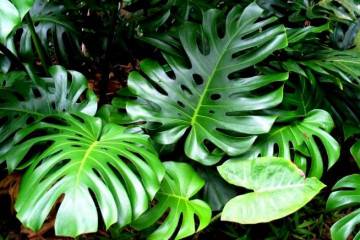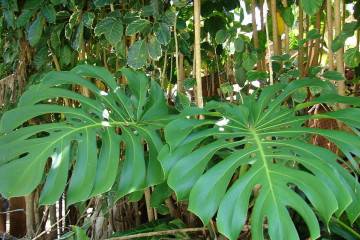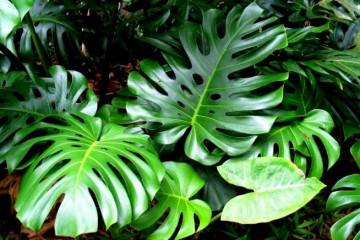Monstera gourmet (Deliciosa) - poisonous plant or not
Content:
The representative of evergreen lianas - delicious monstera, or delicious (in Latin Monstera Deliciosa) - comes from the tropical forests of South America. In nature, it grows up to 12 m in length and has many long and hard aerial roots, which provide it with additional nutrition and also act as a support. Liana uses aerial roots in order to grasp neighboring plants and climb them up.
Biological features of vines
The decorativeness of the plant was the reason for its use in the interior of spacious apartments, offices and other premises. It looks very impressive, grows to a considerable size (3 m), has large perforated leaves. Lives long enough (over 15 years).
Monstera deliciosa bears fruit. Under natural conditions, the liana blooms with large white or creamy inflorescences-cobs covered with a petal-blanket. In indoor conditions, it bears fruit extremely rarely. Even in greenhouses, flowering and fruiting are not common. Fruit ripening occurs within 9-10 months.
Do monstera fruits eat gourmet
The fruit is a large berry with a diameter of 5-9 cm, a length of 25-30 cm. The peel is scaly, the pulp is juicy and aromatic. The berries are edible, with a taste close to pineapple and banana. For this she was called a monstera dainty. The fruits must be eaten when ripe.
Interesting Facts About The Tasty Monster
The berry is quite tasty and nutritious, so this variety is now grown as a fruitful plant in areas with a suitable climate. In the Indian and Australian states, they began to cultivate the monster precisely for the purpose of obtaining its fruits.
Composition of monstera fruits:
- proteins - 1.8 g;
- fats - 0.2 g;
- carbohydrates - 16.2 g;
- fiber - 0.57 g;
- water - 77.9 g
The calorie content of gourmet monstera is 73 kcal per 100 g.
Monstera is poisonous or not
The intercellular space of the leaves of this plant contains thin needle-like formations of calcium oxalate (raffida). When in contact with mucous membranes, they cause severe burning and irritation. If a child or animal eats even a small part of the leaf, toxic poisoning is inevitable. Special care should be taken when there is a cat, dog, or parrot at home that might want to nibble on indoor flowers. Symptoms: numbness and irritation of the mucous membrane of the mouth and throat, pain, swelling, aphonia (loss of voice).
Is it possible to keep a gourmet monster at home
Doubts are associated with numerous myths about the influence of a flower on a person's fate, about the ability of a monstera to absorb oxygen, etc. But all superstitions are not confirmed by anything. Do not be afraid to grow a monster at home. It is quite safe despite its threatening name.
Features of caring for a gourmet monster
The plant is quite unpretentious, therefore it does not require special care. The tropical origin explains the increased demand for indoor air parameters.Its humidity should be at least 60%, temperature - + 22-25 ° C, in winter not lower than + 16-17 ° C.
Monstera deliciosa is light-free and can be grown even in the shade. It is optimal to place the vine in the east or west side of the room. When grown in the sun, it should be protected from direct sunlight. On the north side, the leaves will not be as large and the growth of the vines will slow down.
Watering and fertilizing
Liana needs high-quality watering. It must be constantly monitored so that the earthen lump is not overdried. But at the same time, water stagnation should not be allowed. If the roots rot, the plant will die. In winter, the frequency of watering is reduced.
Top dressing in spring and summer is carried out 2 times a month. It is carried out with complex fertilizers for indoor plants.
A young plant can easily do without support. As he grows, usually by 1.5-2 years, it is necessary to organize him a strong vertical support.
Transfer
Monstera is fast growing, so the young plant is transplanted annually. An adult plant is transplanted as needed, usually every 3-4 years. This should be done carefully, since the aerial roots are very brittle. The pot is chosen according to the size of the root system.
Reproduction methods: vegetatively and by seeds
The most commonly used propagation by cuttings. To do this, the apical cutting is cut off from the mother plant and placed in a moistened substrate for rooting. After the roots appear, the cutting is transplanted to a permanent place.
Reproduction with aerial roots is also possible. They are placed in a container of water. When young roots grow, the upper part of the aerial root is separated from the mother plant and planted in prepared soil.
The easiest way is to propagate by lateral shoots that grow at the base of the stem. They are separated and planted in a container with soil, which is placed in a greenhouse until rooting.
Seeds are placed superficially on the substrate. The soil is moistened and the crops are covered with glass or foil. Seeds germinate for about a month. All this time, they control so that the earthen lump does not dry out. The first young leaves are heart-shaped and only by the 8th month the vine will have leaves characteristic of the variety. After the plant forms a developed root system, it can be planted in a prepared pot with a substrate.
Monstera is undoubtedly a popular houseplant. This majestic vine perfectly decorates not only the home interior, but is often used in office buildings. Liana can be used in combination with other plants. Its luscious green foliage looks especially appropriate in spacious rooms.


















